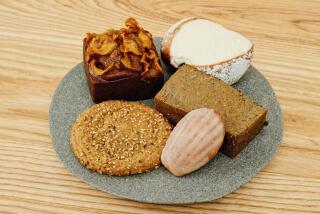U.S. firms feeding Japan’s sweet tooth
TOKYO — After years of staying slim on a humble diet of fish, vegetables and rice, Japanese are developing a sweet tooth. That’s proving to be a business opportunity for Krispy Kreme Doughnuts Inc. and other fast-food chains from the U.S., home of the Big Gulp and super-sized fries.
Since opening in December, Japan’s first Krispy Kreme store is drawing long lines for an hour wait or more. In the first three days, 10,000 people came to the shop.
“The texture was fluffy and sticky, unlike any other doughnut,” said Yoji Yahagi, 22, who stood in line with his girlfriend to eat two chocolate doughnuts each.
The couple is typical of a growing number of Japanese who are gobbling up doughnuts, ice cream, pastries and other calorie-rich goodies. Food writer Mei Hojo says health-conscious eating remains a big trend in Japan, but it has also produced a bit of a backlash -- especially for American-style food.
“People aren’t satiated,” said Hojo, who wrote “Super Calorie Recipes.” “That’s why they are going for doughnuts and ice cream. It’s a search for satiation.”
Krispy Kreme isn’t the only American chain riding on Japan’s latest binge.
This year, McDonald’s Corp. got such rave reviews for the Mega Mac, of which 1.7 million were sold in four days, that it’s bringing back the four-patty burger for this month and May.
Cold Stone Creamery, which arrived in Japan in 2005, has also been a hit. It promised “the ultimate indulgence” in ice cream, tossing in fruit, cookies and nuts. The chain planned to open three stores in Japan in March and two more this month, bringing the total in the country to 13.
And with enthusiasm running high for American food, Burger King Corp. plans to return this summer. It withdrew from Japan in 2001 after a price war with McDonald’s.
The move toward more-filling meals has also been a plus for Japanese companies making super-size noodles, ice cream and deluxe burgers.
The trend is so widespread that Japanese coined the phrase “in-your-face food” to describe it, underlining an apparent desire to escape the stresses of a health-conscious regimen and let go for a change.
“Perhaps behind it is the human psychology that sometimes you crave in-your-face food to forget about counting calories,” top business daily the Nikkei reported recently.
The timing of the shift is ironic, with Americans turning to Japanese foods such as sushi and tofu in an effort to stay trim. Japanese are far skinnier on average than the American population, according to World Health Organization statistics.
Although concern about obesity is increasing here, the weight problem has not reached the epidemic levels of the U.S. Cold Stone Creamery downsized its servings for the Japanese market.
“People are eating sweets and chocolate on this high-calorie fad. But they’re also keeping their intake down in other areas,” said food expert Naoki Nomura, an advisor at the government-funded Japan External Trade Organization, which promotes trade and investment.
Krispy Kreme faces other American-style doughnut chains, including Mister Donut, the sector leader in Japan. The lines that once formed outside Doughnut Plant, a U.S. chain that arrived in Japan in 2004, have long disappeared, and Dunkin’ Donuts was forced to withdraw in 1998.
For Krispy Kreme, Japan is part of a comeback strategy. The chain, based in Winston-Salem, N.C., saw its stock collapse two years ago under the weight of overexpansion in the U.S., an accounting probe and the low-carbohydrate diet craze.
New management has been improving profit margin, and the overseas expansion is part of a revival plan announced this year.
But experts warn that Japan’s fascination with gutsy food could be short-lived.
“Japanese are obsessed with what’s novel and eye-catching,” said Hikaru Hayashi, senior researcher at think tank Hakuhodo Institute of Life and Living. Smart marketing draws instant crowds in Tokyo, but only some products survive the test of time, he said.
Some people thronging Krispy Kreme said they had heard so much talk in magazines and TV shows that they were there to check out what the buzz was about -- including hospital worker Tomoko Izawa, 33, who was rushing to a baby shower clutching a bag filled with 30 doughnuts.
Krispy Kreme has created doughnuts for the Japanese market, such as cherry filling for blossom-viewing season and heart-shaped frosting for that popular cute look, but has kept the basic recipes unchanged.
Like the stores in the U.S., visitors here watch through a glass window as a machine rolls off doughnuts on a shiny conveyor belt. This offers what officials say is entertainment in addition to tasty treats, which have about 250 calories each for a glazed doughnut.
“Sure, it’s not really health-conscious, but this isn’t about that,” said Shinji Kosaka, chief executive of Krispy Kreme Doughnut Japan Co.
Nomura says the eateries that do well in Japan are those that promote a fashionable image.
The same people who are snatching up Krispy Kreme doughnuts are also going to the gym to work off the calories, as well as going to foreign-language lessons, aesthetic salons and romantic restaurants -- all to enjoy a slice of a fairy-tale lifestyle, he said.
“People have seen that big doughnut box in Hollywood movies at executives’ meetings,” Nomura said. “It’s a chance to experience that kind of American culture Japanese people fantasize about.”
More to Read
Inside the business of entertainment
The Wide Shot brings you news, analysis and insights on everything from streaming wars to production — and what it all means for the future.
You may occasionally receive promotional content from the Los Angeles Times.










